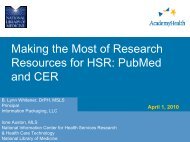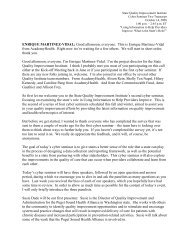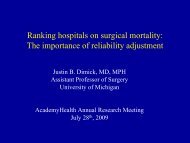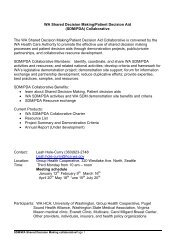Ohio Health Quality Improvement Plan
Ohio Health Quality Improvement Plan
Ohio Health Quality Improvement Plan
You also want an ePaper? Increase the reach of your titles
YUMPU automatically turns print PDFs into web optimized ePapers that Google loves.
Appendix IV — Co m m e n t s f r o mStatewide Or g a n iz a t io n sthe 2008 CMS Physician <strong>Quality</strong> Reporting Initiative(PQRI).• The <strong>Ohio</strong> University College of Osteopathic Medicine(OU-COM) is a leader in information technology.OhiONE and COREnet have been two of the mostinnovative components of the college’s medicaleducation consortium, known as the Centers forOsteopathic Research and Education (CORE). Utilizingthese technology-based systems, the College and itstraining hospitals throughout <strong>Ohio</strong> provide high qualityeducational programs, conduct meetings, and supportresearch across the entire CORE consortium. Thesetechnologies allow our member hospitals to integratepostgraduate training programs and share presentationsby nationally known lecturers. In recent years, OhiONEand COREnet have been so successful that they havegrown into one of the largest interactive systems in theUnited States.• From 1993 to 1999, OU-COM was designated by theU.S. Department of <strong>Health</strong> and Human Services asone of only 25 Centers of Excellence in the UnitedStates (and the only one in <strong>Ohio</strong>) to insure the trainingof a population of physicians who are skilled inmulticultural medicine. Part of the college’s longtermmission is to recruit, educate, train and retaineconomically disadvantaged and minority students insupport of a culturally competent physician work force.• The Osteopathic Heritage Foundations, Columbus,have approved over $100 million in grants designedto improve the health and quality of life of vulnerablepopulations and advance osteopathic medicine inCentral and Southeast <strong>Ohio</strong> since 1999. Communityfunding priorities include: obesity, homelessness andoral health care.<strong>Ohio</strong> State Medical AssociationI. Which strategies or tactics would your organizationbe able to help implement?The <strong>Ohio</strong> State Medical Association (OSMA) is able andwilling to participate in all four priorities. However, theOSMA will have very limited ability and resources to affectinformed and activated patients. The OSMA has limiteddirect access to educating patients. We could however,work with our physician members on messaging to theirpatients.II. Which strategies or tactics are already priorities foryour organization?Patient centered medical home (PCMH) and <strong>Health</strong>Information Technology (HIT) both are a priority for theOSMA. Payment reform is a priority for the OSMA at thestate level, and to the extent that a state medical associationcan affect payment reform as a national issue. Informedand activated patients are not currently a priority of theOSMA.III. What do you believe should be the top priority forthe Council?The four priorities are so complex and interdependent thatone cannot be effective without the others and the groupwould not be as effective if any one part is missing. Thepriorities create a new “system” that can be viewed ashaving two main components, service and payment. Theservice starts with the PCMH which is dependent on HITand informed and activated patients in order to be effective.The payment structure must be different than today’spayment environment in order to support the new system.This raises a challenging question that the health caresystem must address, do we invest in building a systemdesigned to work more effectively and save money in thelong-run, or do we reward through enhanced paymentsa system that has proven to be more effective and savesmoney? In other words, it’s not a question of who’s goingto pay for it, it’s a question of when. The top priority ofthe Council should be to create an implementation strategyinvolving all four interconnected priorities and to addressthe timing of payment reform.IV. What are the opportunities of integration betweenand among the four collaborative transformationalstrategies?As stated above there are not only opportunities forintegration, but it is critical that all four strategies arehighly integrated and happen simultaneously.V. What are your specific comments to any or all of thedecision points?The PCMH system will not function the same way in everycommunity. Each community has different infrastructureand resources and that community must work within theirgiven environment in order to set up a PCMH system thatdelivers the desired outcomes. While systems my looksomewhat different they should all have similar principlesand desired outcomes set for by this Council. The Council41










